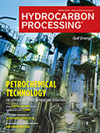March 2002
Special Report: Petrochemical Developments
Mitigate coke formation
A new anticoke technology sustains a noncatalytic layer on cracking tubes that reduces coking

 COPYING AND DISTRIBUTING ARE PROHIBITED WITHOUT PERMISSION OF THE PUBLISHER
COPYING AND DISTRIBUTING ARE PROHIBITED WITHOUT PERMISSION OF THE PUBLISHER
A new anticoke technology sustains a noncatalytic layer on cracking tubes that reduces coking

Comments